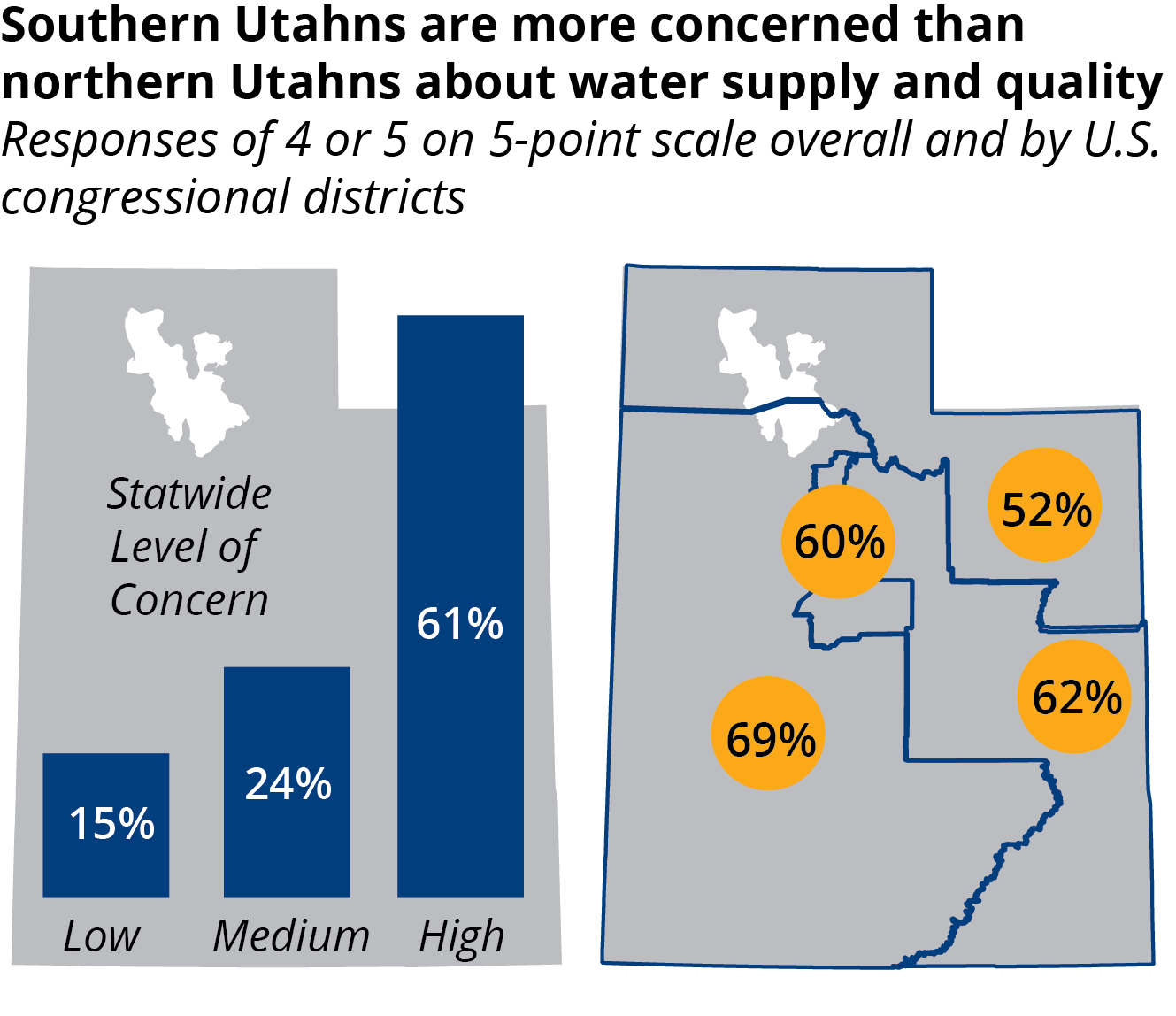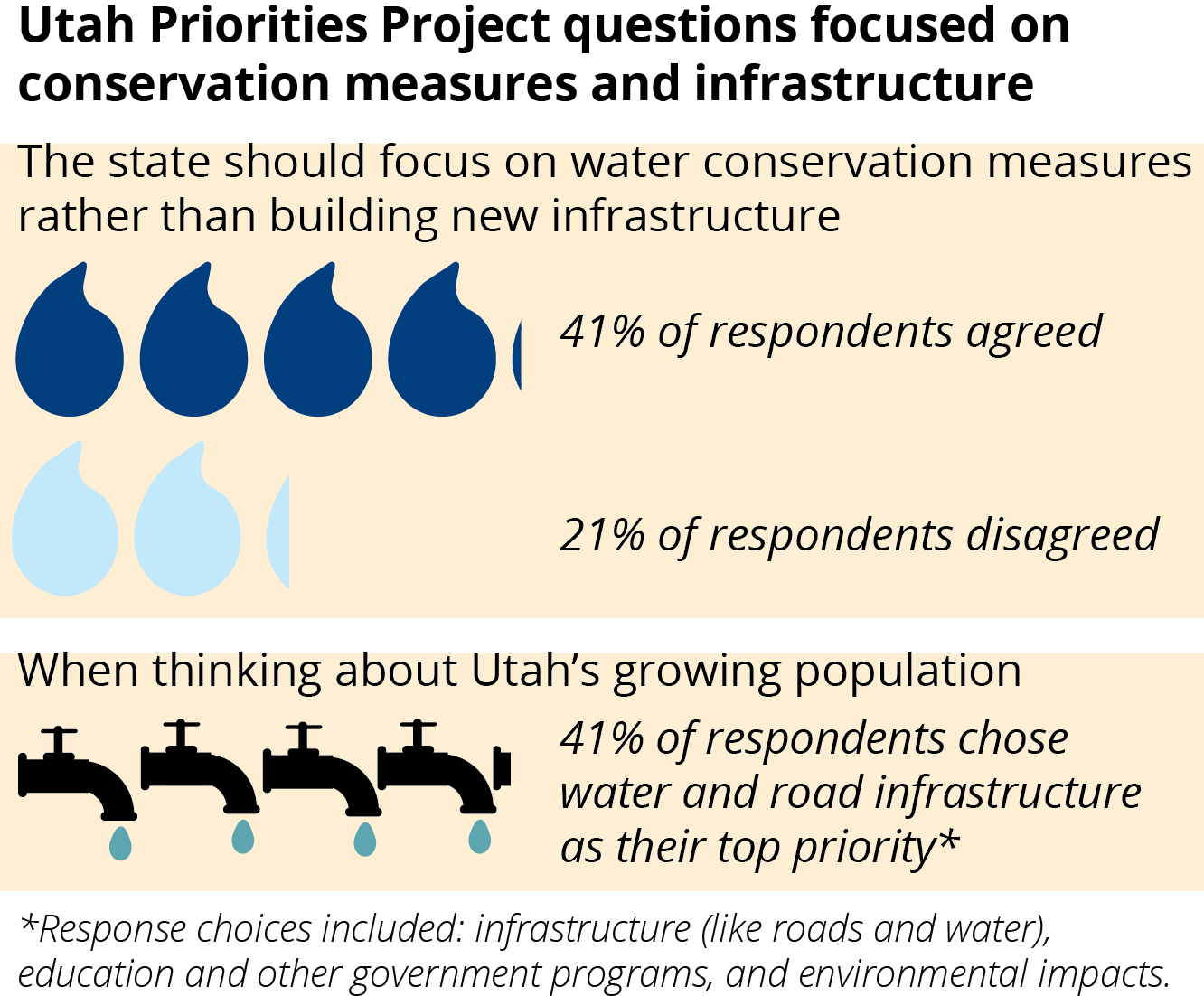Water has bounced back onto the Utah Priorities Project top 10 list after dropping to eleventh place in 2010 and 2012. In this year’s project survey, 61% of respondents indicated concern (a 4 or 5 on a 5-point scale) for water supply and quality.
SURVEY RESULTS
The bump in the rankings could be due to increased media attention on water issues in 2015 and 2016 at both the regional and local level. The drought in much of the West – especially California – and the Gold King Mine wastewater spill in Colorado, brought national attention to western water issues.
Locally, big issues included low water in levels of the Great Salt Lake and Lake Powell, as well as concerted efforts to increase funding for water projects by water districts. Additionally, an audit on Utah’s water needs at the state level was published in 2015 by the Utah Office of the Legislative Auditor General.
Utah Priorities Project survey respondents between 18 and 25 years old had the lowest level of concern about water supply and quality. For all other age groups, 57% or more respondents indicated that water was a concern. Geography also correlated with level of concern. Over two-thirds of respondents living in Utah’s 2nd congressional district, which includes the southwestern portion of the state, chose 4 or 5 for their level of concern.
WATER IN UTAH
There are 11 hydrologic river basins in Utah. These basins all have very different geography and environments which result in very different water scenarios. Most of the state’s population is dependent on water held in snowpack, so variations in precipitation can have a large impact on water throughout the year.1
The majority of Utah’s water is used in agriculture. In 2010, 27 of Utah’s 29 counties showed agricultural uses being the highest portion of water consumption.
Outside of examining the general level of concern regarding water quality and quantity, the Utah Priorities Project survey asked two additional water-related questions. These questions focused on water conservation and infrastructure.
CONSERVATION
Just over 40% of respondents agreed with the statement “the state should focus on water conservation measures rather than building new infrastructure.”
As mentioned above, residential water use in Utah is a small portion (11%) of the overall picture of water usage in the state.4 In 2015, respondents to the Envision Utah “Your Utah, Your Future” survey overwhelmingly indicated that they supported some level of reduction in per person water use.5 Additionally, a recent Utah Policy poll showed that Utahns were strongly in support of voluntary conservation measures throughout the summer months, even though precipitation levels at the time of polling were normal.6
There are efforts underway to increase conservation in agricultural water use as well. In 2016, the Utah State Legislature approved continued funding for the Utah State University Extension Water Conservation Initiative. The USU Initiative uses the funding forapplied research specific to Utah, helping Utah communities enact conservation measures as well as continuing to study water conservation academically.7
INFRASTRUCTURE
An additional Utah Priorities Project follow-up question touched on the idea of water infrastructure. Respondents were asked to choose their top priority when thinking about Utah’s growing population from three options: infrastructure (like roads and water), environmental impacts, or education and other government programs.
Less than half (41%) of respondents chose infrastructure as their top priority when thinking about population growth.
Infrastructure is not cheap. The Statewide Water Infrastructure Plan, produced by the large water conservancy districts, the Department of Water Resources, and several other partners, indicates that the cost to maintain the existing system and build new projects they deem necessary for future growth will be $33 billion over the next 45 years.8 Water infrastructure will continue to be an issue for the foreseeable future.
RECENT WATER RESEARCH AND LEGISLATION
A 2014 report on water by Utah Foundation resulted in several recommendations which were also being voiced by various groups in the water community. The recommendations include: tiered water rates, installation of water metering systems in communities with no metering, further analysis of existing datasets, and increased collaboration between local entities and their water districts to get a better understanding of the connections between water and future development.
In May 2015, the Office of the Legislator Auditor General released a performance audit focused on the projections of Utah’s water needs.9 The audit included several sets of recommendations for legislative action. The recommendations focused on the reliability of water use data, conservation goals, and growth in future planning. This prompted a response by the Legislature during the 2016 General Session.
The legislative response came through 14 water related bills and joint resolutions. Eight of these were passed and signed by the Governor. These bills cover a variety of topics, including water rights and law, infrastructure funding, pricing, accuracy of water data, metering, and quality.
While previous research has shown that metering and tiered pricing for culinary water could have an impact on conservation, the two actions addressing these topics (Senate Concurrent Resolution 001 and Senate Bill 28) leave some wiggle room for local entities.10 SCR001 encourages entities to implement water metering without any attached funding.11 While SB 28 establishes requirements regarding the implementation of tiered water pricing, the legislation does not include any minimum guidelines or information on repercussions for noncompliance.12
Senate Bill 251, “Water Infrastructure Funding Amendments,” directly addresses some of the recommendations of the performance audit. The bill allocated $1,000,000 to the Division of Water Resources and the Water Development Commission to create a more robust and reliable data set, establish new conservation targets based on this data, and use the information gained through this process to analyze future water infrastructure needs.13
This research brief was written by Utah Foundation Research Analyst Mallory Bateman.
- ^ T. Beach, N. Mesner, and Sarah Null, “Exploring Utah’s Water,” Utah State University Extension, Natural Resources, April 2016, http://extension.usu.edu/files/publications/publication/NR_WaterQuaity_2016-01pr.pdf.
- ^ M. Maupin et al., “Estimated Use of Water in the United States in 2010,” US Department of the Interior, US Geological Survey, Circular 1405, http://pubs.usgs.gov/circ/1405/pdf/circ1405.pdf.
- ^ Urban Utahns refers to respondents living in Salt Lake, Davis, Weber, and Utah counties. Rural refers to those in all other counties.
- ^ Communications with Division of Water Resources.
- ^ Envision Utah, “Survey Results for Water,” http://www.envisionutah.org/projects/your-utah-your-future/item/346-results.
- ^ B. Bernick, “Poll: Utahns Say Water Restrictions Should Remain in Place,” UtahPolicy.com, 28 July 2016, http://utahpolicy.com/index.php/features/today-at-utah-policy/10304-poll-utahns-say-water-restrictions-should-remain-in-place.
- ^ “Utah Legislature Looks to USU for Water Conservation,” Press Release, 31 March 2016, http://extension.usu.edu/news_sections/agriculture_and_natural_resources/water-conservation-legislature.
- ^ Prepare60, “Statewide Water Infrastructure Plan,” 2015.
- ^ Office of the Legislative Auditor General, “A Performance Audit of Projections of Utah’s Water Needs,” Number 2015-01, May 2015, https://le.utah.gov/audit/15_01rpt.pdf.
- ^ Utah Foundation, “Flowing Toward 2050: Utah’s Water Outlook,” September 2014.
- ^ Utah Legislature, “Concurrent Resolution Encouraging Universal Metering of Water Systems,” 2016 General Session, SCR001, http://le.utah.gov/~2016/bills/static/SCR001.html.
- ^ Utah Legislature, “Water System Conservation Pricing,” 2016 General Session, SB28, http://le.utah.gov/~2016/bills/static/SB0028.html.
- ^ Utah Legislature, “Water Infrastructure Funding Amendments,” 2016 General Session, SB251, http://le.utah.gov/~2016/bills/static/SB0251.html.




